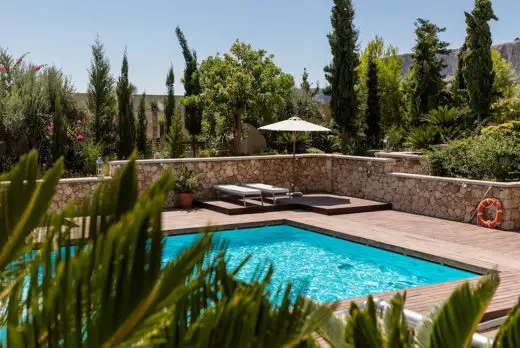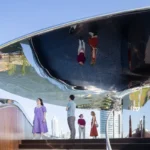10 future trends in spa architecture guide, Property hot tub store tips, Home outdoor relaxation advice
10 Future Trends in Spa Architecture
August 13, 2023
Since health and relaxation are becoming more essential to individuals in today’s fast-paced society, spa architecture may soon experience significant changes. Architects and designers are embracing cutting-edge designs that blend technical developments, ecologically responsible methods, and cultural components to construct the spas of the future. The future of spa architecture is discussed, along with ten well researched topics that are already changing the industry.
Outdoor Oasis Retreats
The modern spa experience will expand beyond the four walls of a building. The architectural designs will take advantage of the outside area, allowing visitors to unwind in an atmosphere that is in harmony with nature.
The rooftop gardens will be a peaceful place for guests to meditate, and the forest bathing zones will help individuals reconnect with nature, which is known to have healing effects. Thermo pools surrounded by lush vegetation will become revitalization centers. Consider a hot tub store pool for outdoor relaxation. These pools will be the first of their kind because they will combine hydrotherapy with environmental immersion.
Hyper-Personalization
Standardized spa designs will become obsolete in the near future. The incorporation of guest preferences and advanced data analytics will pave the way for the advent of hyper-personalization.
Once spas learn what their consumers want, they may customize their services to meet their needs in every way, from the kind of treatments they offer to the colors of the lights and scents they use. Biometric information allows for instantaneous therapy adjustments, leading to individualized care for each patient.
Biophilic Immersion
Biophilic design in modern spas is evolving into a more immersive and harmonious experience, where natural elements meet contemporary aesthetics. Water features and living walls purify the air while creating calming, organic visuals. Natural materials like wood and stone blend seamlessly with modern finishes such as brushed metal, glass, and polished concrete—blurring the boundary between indoor and outdoor spaces. To further enhance both function and style, designers seem to be incorporating aluminium chequer plate sheets for kick plates and wall panels, as well as benches, walkways, and trims—offering durability, safety, and an appealing industrial contrast.
Wellness Technology Integration
The future of the spa sector depends on the incorporation of cutting-edge technologies into spa designs. Individualized treatment programs based on AI-powered wellness assessments will be made possible, and guests will be transported to tranquil settings in virtual reality as they relax under the care of medical professionals. Intelligent building features, such as dynamic lighting and flexible floor plans, will enhance the healing environment. Wearable technology may even allow visitors to track their own state of relaxation, further bridging the gap between built environment and individual health.
Sustainable Sanctuaries
Future spa construction will place a premium on ecological considerations. Spas that take into account environmental concerns by maximizing natural light and ventilation will reduce their reliance on artificial heating and cooling. By using recycled and locally sourced materials and renewable energy to power its operations, the spa will have a smaller impact on the environment. The ultimate objective is to create zero-net-energy spas that not only refresh their patrons but also favorably impact global health.
Cultural Fusion and Authenticity
Incorporating global cultural influences into spa architecture can lend it greater authenticity and depth. The designs will be inspired by traditional methods of health and wellness, with an eye toward utilizing local materials and techniques wherever possible. This trend will help promote global unity and understanding by giving spa-goers access to the healing practices of other cultures without requiring them to travel outside the spa’s walls. The spa experience can be improved by incorporating techniques from diverse cultures, such as those used in Moroccan hammams and Japanese onsens.
Holistic Health Hubs
Day spas will develop into multi-purpose facilities in the near future. By combining medical and wellness treatments, these spas will serve as community health centers. Collaborations with healthcare professionals will lead to all-encompassing wellness programs that consider a person’s physical, mental, and emotional health. These spas will serve as hubs for both preventative and curative medicine due to the design’s capacity to house consultation areas, rehabilitation facilities, and areas dedicated to integrative therapies.
Minimalist Tranquility
There are already too many options for stimulating the senses, thus minimalism design is becoming increasingly popular in spa construction. The design decisions will center on simple shapes, color schemes, and layouts. By adopting a minimalist lifestyle, one can foster an environment where guests can forget about the stresses of daily life and focus instead on being in the present now. Without distractions, participants will be able to achieve deeper states of relaxation and gain greater clarity of thought.
Immersive Sensorial Experiences
Future spa designs will provide more sensory experiences for visitors. Modern music, aromatherapy-infused spaces, and tactile elements will all find their way into the next generation of building designs. Ambient settings designed to stimulate all five senses are expected to induce a state of deep calm and emotional stability. Guests will be taken on sensory adventures that incorporate the building’s aesthetics with healing activities.
Social and Community Wellness Spaces
Spas will evolve into communal health hubs that welcome all members of society. Activities like group meditation, wellness classes, and other get-togethers with a focus on social interaction and stress relief will be hosted at these venues. The design of tomorrow’s buildings will take group dynamics into account, with common areas designed to encourage conversation and the exchange of tips for maintaining health. The spa’s mission will shift from pampering individual customers to fostering community wellness.
10 Future Trends in Spa Architecture Endnote
The merger of technical developments, ecologically responsible design, and culturally significant aspects appears to be driving the evolution of the spa architecture business in the future. Several forthcoming tendencies, such as hyper-personalization, biophilic immersion, wellness technology integration, and many more, will radically alter how we relax and care for ourselves.
If architects and designers are aware of the current trends in the spa business, they may build spaces that inspire, revitalize, and resonate with the evolving needs of the wellness-conscious individual. A new era will usher in a blend of architectural innovation and well-being philosophy, making spa places more than merely destinations but rather transforming journeys toward holistic health.
Comments on this guide to 10 future trends in spa architecture article are welcome.
Swimming Pools
Swimming Pool Design Articles
Swimming Pool Designs
Swimming Pool Building Designs
Important purchases for your new swimming pool

picture : Dim Hou
How to ensure your family swimming pool is child-friendly
Thermal Baths Spas, Germany
Family House Revision & Pool for Art
Swimming Pool Architecture Design Ideas
Property Articles
Comments / photos for the 10 future trends in spa architecture page welcome






